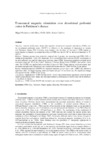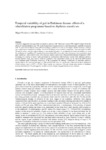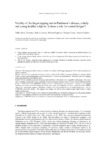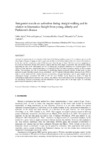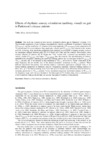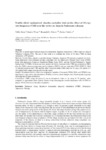Buscar
Mostrando ítems 1-8 de 8
Effect of whole body vibration in Parkinson's disease: a controlled study
(Wiley, 2009-02-06)
[Abstract] In the search of new strategies to improve the quality of life of Parkinson's disease patients, recent work has reported an amelioration of Parkinsonian symptoms using Whole Body Vibration (WBV). A double-blinded, ...
Transcranial magnetic stimulation over dorsolateral prefrontal cortex in Parkinson’s disease
(Elsevier, 2006-11-09)
[Abstract] Objective
Several studies have shown that repetitive transcranial magnetic stimulation (rTMS) over the dorsolateral prefrontal cortex (DLPFC) is effective in the treatment of depression in patients with ...
Temporal variability of gait in Parkinson disease: effectsof a rehabilitation programme based on rhythmic sound cuesTemporal variability of gait in Parkinson disease: effectsof a rehabilitation programme based on rhythmic sound cues
(Elsevier, 2004)
[Abstract] It has been suggested that sequential movements in patients with Parkinson's disease (PD) might be improved by the effects of external rhythmic cues. We studied spatiotemporal gait parameters and temporal gait ...
Validity of the finger tapping test in Parkinson’s disease, elderly and young healthy subjects: is there a role for central fatigue?
(Elsevier, 2012-05-03)
[Abstract] Objective: The main goal of this work is to evaluate the validity of the finger tapping test (FT) to detect alterations in rhythm formation.
Methods: We use FT to study the alterations in motor rhythm in three ...
Antagonist muscle co-activation during straight walking and its relation to kinematics: Insight from young, elderly and Parkinson's disease
(Elsevier, 2012-03-21)
[Abstract] Increased antagonist muscle co-activation of the lower limb during walking seems to be an
adaptive process to the physiological changes of aging, in order to gain joint stability. In the
healthy subjects this ...
Effects of rhythmic sensory stimulation (auditory, visual) on gait in Parkinson’s disease patients
(Springer, 2008-01-23)
[Abstract] This study has focused on how sensory stimulation affects gait in Parkinson’s disease (PD). The kinematic parameters of gait [cadence, step amplitude, velocity, coefficient of variation of stride time (CVstride-time), ...
Evaluation of the effect of training using auditory stimulation on rhythmic movement in Parkinsonian patients—a combined motor and [18F]-FDG PET study
(Elsevier, 2006)
[Abstract] Introduction: A programme of rehabilitation using auditory cues has previously been shown to decrease movement variability in the gait of Parkinsonian patients.
Objective and methods: We studied the temporal ...
Double-blind, randomized, placebo controlled trial on the effect of 10 days low-frequency rTMS over the vertex on sleep in Parkinson’s disease
(Elsevier, 2010-07-31)
[Abstract] Objective: A recent report indicates repetitive transcranial magnetic stimulation (rTMS) improves sleep
in Parkinson’s disease (PD). The aim of this work is to evaluate the effect of 10 days rTMS on sleep ...



